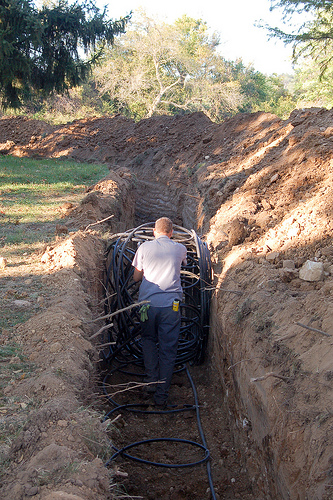22
2011
Digging Geothermal Closed Loop Trenches
 The most commonly installed kind of geothermal heat pump is a closed loop system. In a closed loop, pipes are buried in the area around the house in order to circulate water and refrigerant to transfer heat in or out of the house as needed. When the system needs heat it absorbs it from the ground and when it does not it leaks it out. This energy transfer equates to significant savings as opposed to traditional heating and cooling machines.
The most commonly installed kind of geothermal heat pump is a closed loop system. In a closed loop, pipes are buried in the area around the house in order to circulate water and refrigerant to transfer heat in or out of the house as needed. When the system needs heat it absorbs it from the ground and when it does not it leaks it out. This energy transfer equates to significant savings as opposed to traditional heating and cooling machines.
With anything that requires piping to be installed underground, there is going to be something digging required. One of the more popular methods for installation is a horizontal layout that requires trenches be dug on the property. These trenches are usually four to six feet deep. The pipes are then placed horizontally and a water/refrigerant mix is circulated inside them to provide the necessary functions. There are some advantages and disadvantages to digging trenches for a closed loop system like this.
The biggest disadvantage for closed loop trenches is that it is impossible to do if you lack the necessary space around the location where you want to install a geothermal heat pump. The trenches do not require a massive surface area, but there is a minimum amount and if that is unavailable they are simply not an option. Of course, the pipes can be laid very flexibly and can fit the contours of the property available. The biggest advantage though is it is generally cheaper to dig trenches a few feet deep and is easy to do compared to some other methods.
Whether you are able to use a trench dig for your geothermal heat pump or not, you will certainly benefit from the energy reductions and cost savings that comes with installing one.





